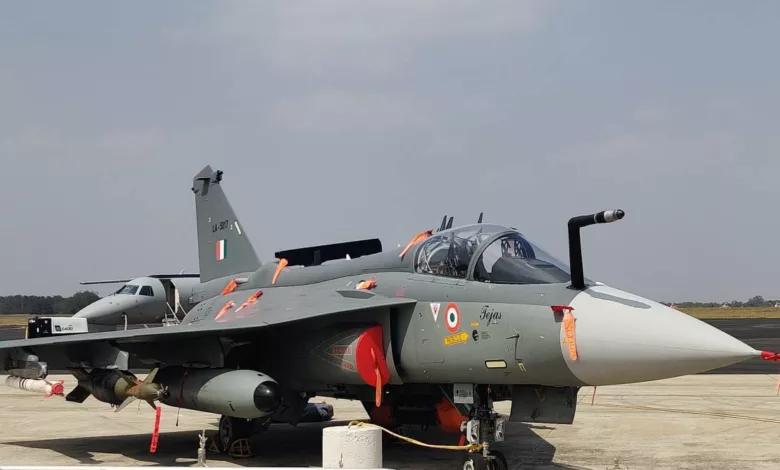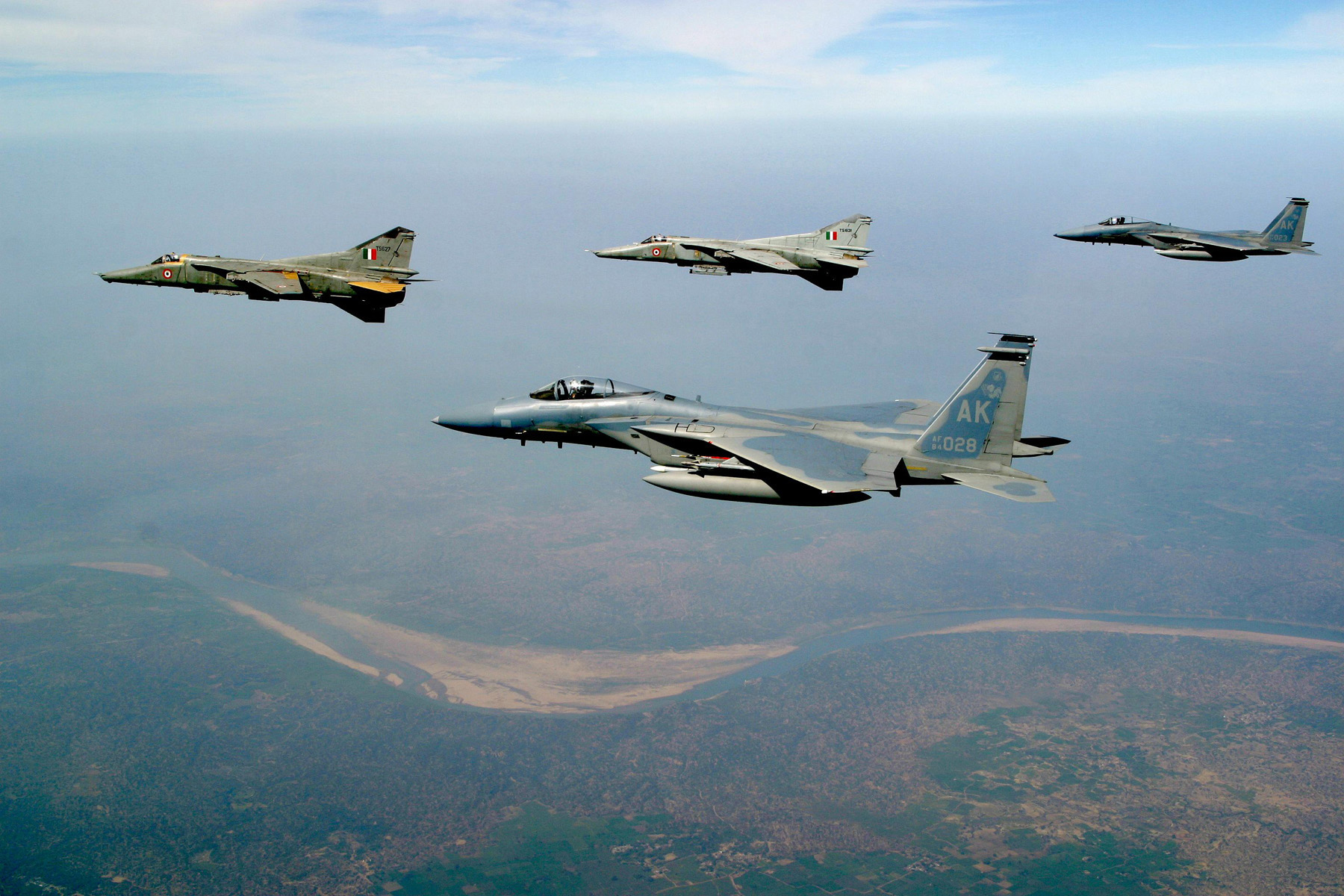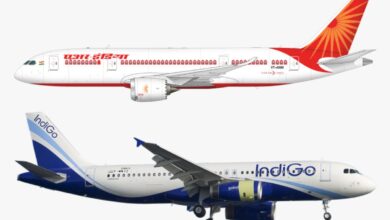Tejas To Take Part In Military Exercise For The Very First Time In UAE
110 Air Warriors from the Indian Air Force have arrived at the United Arab Emirates Al Dahfra airport to take part in the exercise, which will feature two C-17 Globemaster III and five LCA Tejas, the Indian Air Force announced.

Operation Desert Flag VIll, an international multilateral air exercise, will feature India’s homegrown Tejas, a light combat aircraft for the first time, highlighting India’s growing attempts to promote the jet on the international scene.
110 Air Warriors from the Indian Air Force have arrived at the United Arab Emirates Al Dahfra airport to take part in the exercise, which will feature two C-17 Globemaster III and five LCA Tejas, the Indian Air Force announced. The drill will take place between February 27 and March 17.
The Aeronautical Development Agency (ADA) and Aircraft Research and Design Centre (ARDC) of Hindustan Aeronautics Limited (HAL) collaborated to create the HAL Tejas, an Indian single-engine, delta-wing, and light multirole fighter. It was created as a result of the Light Combat Aircraft (LCA) programme, which was first started in the 1980s to replace India’s outdated MiG-21 fighters, but later integrated into a larger programme for fleet modernization. The LCA was given the official name “Tejas” in 2003. It is the smallest and lightest modern supersonic combat aircraft in its class.
After the HAL HF-24 Marut, this light combat aircraft is the second HAL fighter designed with supersonic performance in mind. The first operational clearance for this light combat aircraft came in 2011 and the final operational clearance came in 2019. While No. 45 Squadron IAF Flying Daggers was the first unit to replace its MiG-21s with the Tejas, the first Tejas squadron began operations in 2016.

According to the IAF, Exercise Desert Flag is a multilateral air exercise in which the air forces of the US, UAE, France, Kuwait, Australia, Bahrain, Morocco, Spain, the United Kingdom, and the United States will take part. India had also hoped to offer Malaysia the platform, but Malaysia has already agreed to buy 18 FA-50 light combat aircraft from Korean Aerospace Industries.
Around 16 countries have expressed interest in the LCA Mk 2, which received cabinet approval last year. Efforts are being made to locate private organizations to speed up the jet’s construction.
Astonishing Design Of Tejas
The plane had previously taken part in air displays in Singapore, Malaysia, Bahrain, and Dubai. A tailless, compound delta wing combat aircraft with “relaxed static stability” for improved maneuverability and agility, the Tejas is a single-engine multi-role aircraft.
This light combat aircraft has eight hardpoints: three under each wing, three of which are wet hardpoints that can accommodate drop tanks, one beneath the port-side air intake, one under the fuselage (centreline station), and one elsewhere.
On the starboard side of the forward fuselage of the Mark 1A is an aerial refuelling probe. The I-Derby ER and Astra air-to-air missiles that operate beyond visual range as well as the R-73, Python-5, and ASRAAM close-combat missiles make up Tejas weaponry.
Under the starboard side air intake, it carries an internal 23 mm Gryazev-Shipunov GSh-23 twin-barreled autocannon. For the Tejas, the BrahMos-NG supersonic cruise missile is being created. The aircraft’s overall radar cross-section is decreased by its relatively smaller size, substantial use of airframe composites, the Y-duct inlet that protects the engine compressor blades, the use of radar-absorbent material (RAM) coatings, and other factors.

The Tejas is a versatile combat aircraft that can perform air-to-surface, anti-shipping, and intercepting missions all in one flight. Tejas’ design has been optimised for low wing loading, as well as for minimizing transonic and supersonic wave drag, using wind tunnel testing and computational fluid dynamics research.
Operational Background
No. 45 Squadron IAF (Flying Daggers), the first Tejas squadron, started flying in July 2016 and is headquartered at Sulur Air Force Station in Coimbatore. On May 27, 2020, Sulur saw the formation of Squadron 18, the second Tejas Mark 1 squadron. At the fourth Bahrain International Airshow on January 21, 2016, the Tejas Mark 1 made its debut internationally.
The complete Tejas Mark 1 aircraft fleet of the IAF took part in the Gagan Shakti 2018 training exercise in April 2018. It was the largest air exercise ever conducted by the IAF, comprising 15,000 military men and 1100 aircraft. The Tejas was deployed to forward bases throughout the drill and displayed their dependability and capacity for pinpoint strikes. Six Tejas fighter planes took part in the Vayu Shakti air exercise in 2019 to exhibit their “swing-role” ability.
Group Captain Samrath Dhankhar, the commanding officer of No. 45 Squadron, claims that DASH IV HMDS enables the Tejas pilot to fully utilise high off-boresight close combat missiles like the Python-5 and R-73.

Early Bids
With early negotiations taking conducted with several friendly nations, HAL suggested exporting the Tejas. To export the Tejas, it was claimed in March 2020 that HAL was prepared to establish logistical facilities in Vietnam, Indonesia, Malaysia, Sri Lanka, and Malaysia.
Egypt
Egyptian officials expressed interest in purchasing 70 LCA Tejas[144] during the Dubai Airshow 2021 to replace their 100 Hongdu JL-8 trainers built in China. Following the Dubai Airshow 2021, representatives from HAL and the Indian Air Force visited Cairo and negotiations were under progress. India has promised to establish local production facilities in Egypt for the LCA Tejas, as well as the Light Utility and Light Combat Helicopters, as of June 2022.
Malaysia
The HAL Tejas made its international debut at the Langkawi International Maritime and Aerospace Exhibition (LIMA) in March 2019. According to reports, this event attracted a lot of attention, particularly from the RMAF and the then-Malaysian Prime Minister Mahathir bin Mohamad.
Due to diplomatic squabbles between India and Malaysia, particularly Malaysia’s divisive comments over India’s abrogation of Article 370 and India’s response of banning Malaysian-produced palm oil, HAL’s prospects of exporting the HAL Tejas to Malaysia were badly damaged by mid-2019.
The best option for Malaysia’s fighter jet programme was the Tejas aircraft
As Malaysia prepares to replace its ageing fighter jet fleet and the two parties are in talks to move the acquisition process along, India’s small combat aircraft, the Tejas, has emerged as the top option.

Despite fierce competition from China’s JF-17 jet, South Korea’s FA-50, Russia’s Mig-35, and the Yak-130 plane, Malaysia has reduced its search to the Indian aircraft, according to an interview with R. Madhavan, Chairman and Managing Director of Hindustan Aeronautics Ltd (HAL). Following Mahathir’s retirement as prime minister and the restoration of the Indo-Malaysian palm oil trade, the diplomatic skirmishes came to an end in 2020.
India has proposed to establish an MRO facility in Malaysia for its fleet of Russian-made Su-30 fighters as part of the deal because it is having trouble obtaining spare parts from Russia due to Western sanctions against Moscow.
edited and proofread by nikita sharma




